In a rare and thrilling wildlife moment, a group of tourists traveling through the Spiti Valley in Himachal Pradesh encountered a snow leopard, an animal famously difficult to spot in the wild.

Overview of the Snow Leopard
The snow leopard (Panthera uncia) is a medium-sized wild cat known for its elusive nature and adaptation to the mountainous landscapes of Central and South Asia.
Though its habitat spans over 2 million square kilometers, current estimates suggest that only 3,920 to 6,390 individuals remain in the wild.
Nicknamed the “ghost of the mountains” due to its elusive presence, this predator is rarely seen by humans despite its wide distribution.
Habitat and Geographic Range
- Elevation Range: Lives at 1,800 meters in winter and migrates up to 5,500 meters during the summer months.
- Global Presence: Found across 12 nations including China, Nepal, Bhutan, India, Pakistan, Russia, and Mongolia.
- In India: Common in the Himalayan regions—notably in Jammu & Kashmir, Himachal Pradesh, Uttarakhand, Sikkim, and Arunachal Pradesh—across cold, high-altitude terrains.
Physical Characteristics
- Coat: Thick, pale grey fur patterned with dark rosettes that help it blend into rocky landscapes.
- Fur Layers: The dense undercoat offers insulation, while the longer outer coat (about 2 cm) shields against strong mountain winds.
- Size: Reaches a length of up to 7 feet (2.1 meters)—half of which is its long, bushy tail, essential for balance and warmth.
- Height & Weight: Stands approximately 2 feet (0.6 meter) at the shoulder; weighs between 27 to 54 kg (60–120 pounds). Males are generally larger.
- Behavior: Typically solitary, except during mating season or when a female is rearing cubs.
Conservation Status
- IUCN Red List: Vulnerable
- CITES: Listed under Appendix I
- India’s Wildlife Protection Act (1972): Schedule I, granting it the highest level of protection




